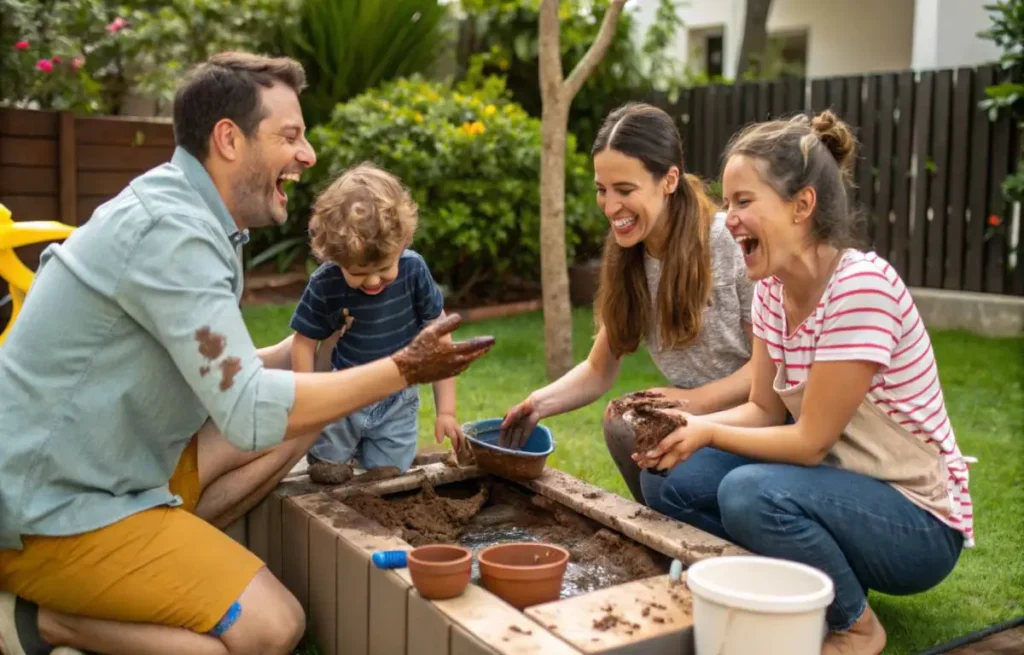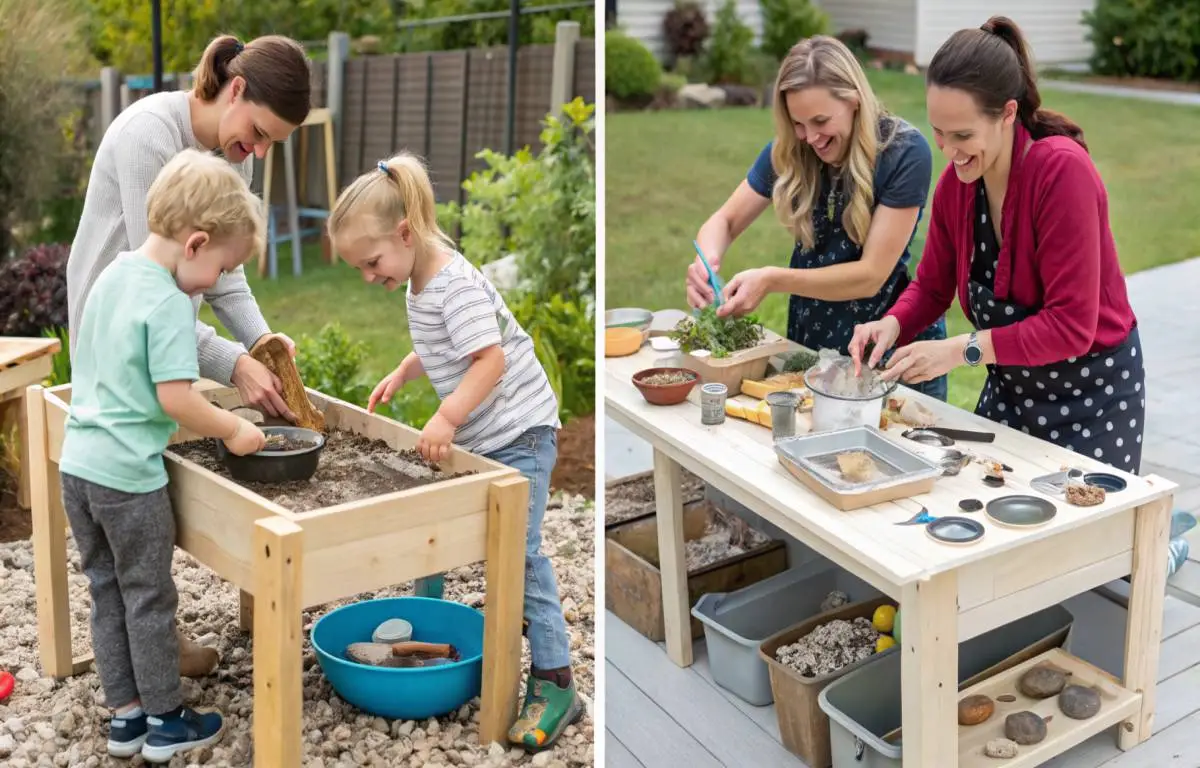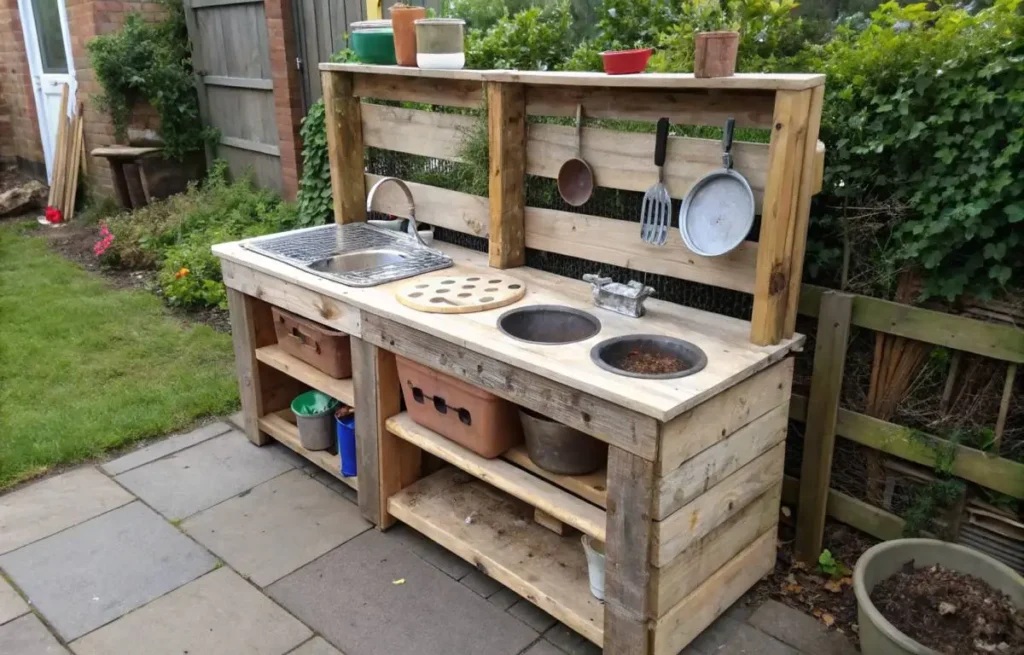Mud kitchen ideas are a fantastic way to spark creativity and outdoor play for children. These outdoor play areas encourage hands-on learning, exploration, and imaginative play, all while keeping kids engaged with nature. Whether you’re looking to build a simple setup or create an elaborate outdoor space, mud kitchens offer endless possibilities for fun and growth. This guide will provide you with creative and practical mud kitchen ideas that will inspire you to create the perfect outdoor play station for your children.
Why Mud Kitchen Play Strengthens Family Bonds

Mud kitchens are more than just a fun outdoor play activity; they offer profound opportunities for family bonding. At their core, these creative setups encourage shared experiences, emotional connections, and collaborative learning, which are fundamental to family relationships.
How Mud Kitchen Ideas Foster Meaningful Parent-Child Interaction
A mud kitchen is not just a space for kids to play; it’s a platform where parents and children can engage in meaningful interaction. The nature of mud kitchen play often requires collaboration. Parents and children work together to gather materials, create their setups, and even “cook” with mud, all of which strengthen their relationship. Research on early childhood development supports the idea that engaging in unstructured play helps build stronger emotional connections. According to the American Academy of Pediatrics (AAP), children benefit from play that encourages parental involvement, fostering trust and empathy between parents and their children.
The Role of Unstructured Play in Building Emotional Connections
Unstructured outdoor play, such as using a mud kitchen, allows children the freedom to explore, be creative, and problem-solve in ways that organized activities do not. This freedom nurtures independence, confidence, and emotional intelligence. For parents, it’s an opportunity to step away from structured activities and simply “be” with their children, building a bond based on shared joy and exploration.
Why Shared Outdoor Time Beats Screen Time for Bonding
In today’s digital age, families often face the challenge of balancing screen time with quality family time. Mud kitchens offer a natural solution to this dilemma. By spending time outdoors and getting dirty together, families can break free from digital distractions. Studies have shown that outdoor play is essential for developing social skills, creativity, and emotional intelligence in children. Furthermore, it encourages family members to engage without the interruptions of technology. The National Institutes of Health (NIH) suggest that outdoor play helps improve both physical and mental health, contributing to stronger family bonds.
7 Mud Kitchen Ideas to Get the Whole Family Involved

Creating a mud kitchen is a great way to involve every member of the family. With just a few materials and a little creativity, everyone can play a part. Here are seven mud kitchen ideas that will get the whole family involved in the fun.
Mud Kitchen Ideas with Roles for Every Age Group
One of the unique aspects of a mud kitchen is that it can cater to different age groups. Younger children can help mix mud, fill containers, and play with the materials, while older children can take on more complex tasks like building structures or designing their cooking area. Parents can supervise, offer guidance, and join in the fun, setting an example for teamwork and collaboration. The Reggio Emilia educational philosophy emphasizes the importance of social interaction and shared activities in learning, which is why mud kitchens are ideal for family involvement.
Easy Mud Kitchen Upgrades Parents Can Do with Kids
Mud kitchens don’t have to stay basic. Parents can create opportunities for upgrades that engage kids in building and crafting. For instance, adding recycled materials like an old sink, a pallet counter, or some vintage kitchenware can elevate the space. This hands-on work not only makes the mud kitchen more fun and functional but also teaches kids valuable DIY skills. According to a report by the National Association for the Education of Young Children (NAEYC), hands-on activities encourage problem-solving skills and creativity in children.
How Inclusive Mud Kitchen Setups Build Cooperation
Mud kitchens are inherently collaborative. Designing one with the input of every family member—whether through choosing colors, arranging furniture, or determining the layout—can teach kids about cooperation and shared decision-making. Having everyone involved in this process creates a sense of ownership and strengthens the family dynamic. Experts from Montessori schools believe that providing children with choices and involving them in decision-making processes fosters a sense of responsibility and teamwork.
Creative DIY Mud Kitchen Ideas Using Household Items

One of the best aspects of mud kitchens is that they don’t require expensive materials. Many creative setups can be made using items already in your home. Here are a few ideas for DIY mud kitchens that incorporate household items.
Genius Mud Kitchen Ideas from Recycled Home Items
Repurposing household items for a mud kitchen is not only eco-friendly but also cost-effective. Old wooden crates, metal containers, or unused kitchen items can be transformed into functional kitchen tools for the mud kitchen. For example, an old sink can become a “wash station” for cleaning up after a muddy day of play. According to Earth Day Network, upcycling household items helps reduce waste and contributes to a more sustainable lifestyle.
Budget-Friendly Mud Kitchen Ideas Families Love
If you’re looking to create a mud kitchen without breaking the bank, focus on using items like wooden pallets, an old table, or plastic containers. These budget-friendly materials can easily be turned into functional kitchen elements. Parents can involve their kids in sanding down wooden pallets, decorating items, or assembling the pieces together, which adds to the experience of creating something useful and fun from scratch. The University of California Agriculture and Natural Resources highlights that involving children in tasks such as building or crafting not only teaches skills but also strengthens their sense of pride and accomplishment.
Transforming Clutter into Play: Upcycled Mud Kitchen Ideas
A cluttered garage or attic can hold a treasure trove of items that are perfect for a mud kitchen. Old pots, pans, spoons, and bowls can be repurposed as cooking tools. Broken toys or outdated garden tools can also be recycled into the setup. The goal is to create a functional yet imaginative play space using items that might otherwise go to waste. The EPA reports that upcycling is an effective way to divert waste from landfills and conserve resources.
Mud Kitchen Safety and Clean-Up Tips for Families

While mud kitchens are fun, safety and cleanliness should always be a priority. Here are a few essential tips for ensuring that your family enjoys mud kitchen play without any worries.
How to Make Mud Kitchen Ideas Safe for Toddlers
Safety is crucial when it comes to mud kitchen play, especially for younger children. Make sure that all materials used are non-toxic and free from sharp edges. Set up the mud kitchen in a safe, enclosed area where children can play freely without worrying about harmful objects or dangerous terrain. Additionally, always supervise toddlers while they play to ensure they don’t ingest harmful substances. The Centers for Disease Control and Prevention (CDC) emphasizes the importance of supervision during outdoor play, especially for younger children.
Cleaning Hacks to Keep Mud Kitchen Play Manageable
Mud kitchens are meant to get dirty, but cleaning up doesn’t have to be a chore. Set up a cleaning station near the kitchen, complete with a small hose, towels, or a wash bucket to rinse off hands and feet. Keeping a small supply of soap and wipes nearby can help manage the mess while encouraging kids to clean up after themselves. According to the American Cleaning Institute, it’s helpful to establish a routine for cleaning up after outdoor play, teaching kids responsibility and the importance of cleanliness.
Sanitation and Supervision: The Family-Friendly Approach
Supervision is key to maintaining a safe and sanitary play environment. Ensure that children wash their hands thoroughly after playing with mud, especially before eating. Create a simple system where kids can rinse off mud at a nearby water station or set of buckets. This makes it easier for children to transition back into the house without bringing too much mess indoors. The World Health Organization (WHO) stresses the importance of handwashing in preventing the spread of germs, particularly after playing outdoors.
Real Stories: Families Who Bonded Over Mud Kitchen Play

While we can discuss all the benefits and tips, nothing quite compares to hearing from real families who have experienced the joy of mud kitchen play firsthand.
Mud Kitchen Ideas That Brought Our Weekends Back to Life
For one family, weekends became more meaningful when they introduced a mud kitchen into their backyard. What started as a simple idea for outdoor play turned into a cherished family tradition. Spending hours together in the backyard, cooking up “mud pies” and creating imaginative worlds, brought them closer in ways they hadn’t expected. Personal stories shared on Pinterest often highlight how mud kitchens serve as a focal point for family gatherings and quality time.
How One Family Made a Tradition from Their Mud Kitchen
Another family shares how their mud kitchen became a weekend ritual that helped them reconnect after busy workweeks. The parents enjoyed watching their children’s creativity unfold as they took on roles as chefs, gardeners, and builders. It became a tradition that, over time, brought joy and laughter while teaching valuable lessons about teamwork, responsibility, and creativity.
Emotional Wins: Stories of Growth from Muddy Moments
One family recalls how their mud kitchen experience was pivotal in helping their shy child build confidence. Through outdoor play, the child learned how to express themselves creatively, and with the help of their parents, they developed stronger social skills and a sense of independence. Educational experts agree that sensory and imaginative play fosters emotional growth and self-esteem in children.
Conclusion
A mud kitchen is more than just a play space—it’s a tool for family connection, emotional growth, and hands-on learning. By embracing the creativity, teamwork, and fun that a mud kitchen brings, families can spend meaningful time together, away from the distractions of screens and technology. Whether you build one from scratch or repurpose old household items, the benefits are undeniable. From boosting children’s social skills and independence to providing parents with the opportunity to reconnect with their kids, a mud kitchen truly becomes a space where family bonds are nurtured. So, roll up your sleeves, get muddy, and enjoy the lasting memories you’ll create in your very own family mud kitchen!
FAQs
What age is best for a mud kitchen?
Most children enjoy mud kitchen play from age 2 to around 8, but it depends on the child’s interest and creativity.
What materials can I use for a DIY mud kitchen?
Common items include pallets, old sinks, plastic bowls, spoons, and recycled kitchen tools.
Is mud kitchen play educational?
Yes, it encourages sensory play, creativity, role-playing, and even early science skills like mixing and measuring.
How do you keep a mud kitchen clean?
Set up a rinse station, use washable materials, and encourage kids to help with tidying up after play.
Can mud kitchens be used indoors?
While designed for outdoor use, a mud kitchen can be adapted indoors using dry materials like sand or rice.
Would you like these styled in HTML format or added directly to your article draft?
People Also Read
